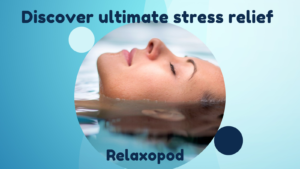FLOAT THERAPY FOR NECK AND BACK PAIN
Relief From Neck and Back pain
Do you seek an alternative to medication and surgery for neck and back pain?
When used as part of a regular treatment plan, flotation therapy has shown exceptional efficacy in reducing chronic pain, including neck and back pain. It also aids in the correction of spinal misalignment problems.According to statistics, heart disease and persistent back pain are the two most common conditions. 70–90% of people are predicted to experience lower back pain in some capacity at some point in their life. The origin of pain and how each person experiences it are both influenced by how much their muscles are relaxed and how stressed their nervous system is overall. The sensory deprivation tank creates a state of physical relaxation that is particularly good for healing, especially for people who have been injured or have chronic pain.The body may more effectively direct its resources toward maintenance and repair because the impacts and pressures of gravity are less.
Long-lasting pain relief may result from combining this treatment with other therapies including massage, yoga, and other forms of exercise.
How Can Neck and Back Pain Be Alleviated With Float Therapy?
A growing corpus of scientific research demonstrates that floating therapy can dramatically reduce pain for a variety of reasons, including:
- Reducing the nervous system’s overstimulation
Floating has an impact on the autonomic nervous system, a network of circuits that carries pain impulses, as well as on the subjective feeling of pain. Intense pain is seen as being lessened by a drastic reduction in external sensory inputs because there is less stimulation of the nervous system.
- Enhanced endorphin production
Endorphin release is increased by relaxation and a decrease in sensory stimulation, which is related to pain relief on a biochemical level. In several tests, it was consistently found that test subjects’ blood contained higher concentrations of natural opiates.
3. Enhanced absorption of magnesium
Magnesium, a natural painkiller that also improves several physiological biological processes, is crucial for pain management. Studies have shown that giving magnesium to people who have suffered spinal cord injuries right away improves both short- and long-term prognoses. Since magnesium is easily absorbed through the skin, you’ll be sure to absorb a lot of it thanks to the nearly 600 kg of Epsom salts in each of our pods.
4. Orthopedic advantages of weightlessness
The body might adopt a position that is unlike lying on a bed, bath, or any other surface when floating in a saturated Epsom salt solution. These qualities describe this particular position:
The back is very straight. The function of individual vertebrae is not compromised. Each muscle group can unwind independently. Ligaments, bones, joints, and intervertebral discs are all alleviated.Hereby acute and chronic tension is released and slipped discs, joint pains, sciatica, lumbago, pulled muscles or sprains improve.
Spine and Float Therapy
The spine is where almost all types of back pain start. The spine must adjust to pressure in a variety of circumstances because it supports the weight of the torso. Chronic pain is frequently caused by misalignment, one-sided strain, or aging-related wear and tear.
There are three main sections that make up the spine:
Vertebral column
Cervical spine
Spinal column
Each area is linked to specific issues and types of pain:
Vertebral column
Even though the cervical spine is the weakest, obstructions in the joints frequently cause pain. The vertebrae can regenerate in an entirely new fashion when they are suspended in a flotation pod, lying free from any pressure or strain. This treatment has a very strong pain-relieving impact.
The Cervical Spine and Floatation Therapy
Thoracic spine Pain in the thoracic spine is less frequent but can still be very severe. The ribs are joined to the spine at places where improper motion or mishaps can cause issues. Experience has proven that when the thoracic spine is not weighted down by gravity and is in a completely relaxed position, the healing process of bruises, breaks, or sprains is sped up.
Lumbar spine or the lower back
The lowest part of the spine, which bears the whole weight of the torso, is where most cases of back discomfort start. Daily fluid loss occurs in the intervertebral discs, which serve as the spine’s shock absorption system. The amount of replenishment of the discs decreases.As we age or when the spine is under a lot of stress and the intervertebral discs gradually shrink, the amount of disc replacement decreases. As a result of lessened muscle tension, the lumbar spine advances. Chronic back discomfort results from this, which can sometimes substantially limit one’s range of motion.
By allowing intervertebral discs to recover and by decreasing spinal deformation processes, floating counteracts the aforementioned processes.
The lumbar spine is frequently connected with slipped discs. Lumbar tissue can press against the spinal nerves when a disc is out of place, resulting in excruciating pain that may even radiate down into the legs. It may also irritate the nerves or result in other symptoms. Refloating can be employed as a helpful kind of post-operative rehabilitation. In order to reduce discomfort and help the body naturally heal spinal problems, flotation therapy can be a useful addition to physical therapies and exercise. Floating is a good treatment for chronic back pain. Create a regular float routine and try it out for yourself! Using a non-invasive, drug-free procedure, experience total weightlessness and pain alleviation.



